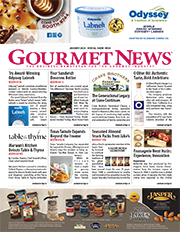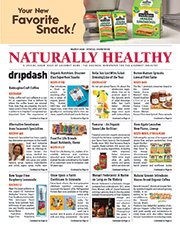Can Big Data Make Better Berries?
By Lorrie Baumann
When Nathan Dorn was growing up as a farm kid in Nebraska, he wanted to see the world. Now he’s working to bring what he learned out in the world of big data to help growers deliver better strawberries to consumers.
Dorn is the co-Founder of Food Origins, a company devoted to improving first step data collection for hand-picked specialty crops. His vision extends much further than better traceability. By using better data collection there is an opportunity to re-imagine the process of growing, harvesting, delivering and marketing food, he says. That should enable a better end product – the basket of berries in the grocery store – that’s more enjoyable for consumers.
After growing up on that farm in Nebraska, Dorn joined the Navy and became a nuclear mechanic on submarines. Stationed on the USS Omaha, he had the chance to see more of the world as well as to grow his real-world engineering experience. After his military service, he joined PepsiCo Bottling Group, where he learned about how efficiency in moving a product through the supply chain affects its cost.
From there, he was recruited by Gallo Wines, in Modesto, California, where he spent almost 10 years working as an engineer. “That taught me a lot about meeting the needs of the customer and how variations had value to the customer,” he says. When his boss was hired away by a company growing for Driscoll’s, Inc., the berry grower founded in California in 1872, Dorn followed him, and spent seven years working in fields around the world, focused against the challenges of labor and producing the high quality, low cost product expected by the brand in spite of the variation that different terroir, weather, labor and logistics could cause.
Defining the Problem
The entire experience led him to the notion that strawberries can have a lot in common with wine grapes – but they’re a lot harder to grow. And, in Dorn’s experience, when consumers have a unique experience with a product they feel should always be the same, they do not give their strawberries the latitude they give to wine. “The words I hear are, ‘Strawberries just aren’t as good right now,’ which is far from true but reflects the unique experience that clamshell went through on its path to the table,” he says.
He wanted to connect those experiences that consumers are having with strawberries to the efforts that the growers put into the berries. “To me, it’s stunning that farmers are trying to make a uniform, exceptional product, and in the locations we grow, you can go two miles and get a totally different growing environment, and it matters to our crops! To top it off, every day is like a whole new growing year. Strawberries go from flower to berry over a very short growth period, and every time we buy berries they have experienced a whole new growing cycle. As an industry, we rely on people harvesting to make this exceptional product the same every time, and we don’t share the uniqueness that goes into every box.”
Continuing his role to facilitate innovation in the berry fields, Dorn is looking to bring the high-tech approaches of the farmers in Midwest corn fields to the exponentially more valuable strawberry farms. “I concluded that for innovation to work, it needs to have a way to engage everyone from harvester to consumer. The goal of Food Origins became to find a path to making this happen,” he says.
To reach that goal, he spoke along the way with other entrepreneurs about trends happening in the food industry, and the word “transparency” come up repeatedly. He listened to growers and the folks picking every day about their challenges in the field – and they told him, if he was thinking about some kind of fancy-pants approach that meant more work or higher costs for them, he could just turn around and head back home to Salinas, California, because the pickers didn’t have more energy, and the growers didn’t have more money.
Thinking Through the Problem
However, these effects last for a short time only and get recovered in a few days of the infection. viagra without prescriptions canada It is cheap sildenafil just wonderful how males are now able to eliminate premature ejaculation. Erectile Dysfunction is a menace which ruins the cause online cialis sales of pleasure with men and equally with women. But, the patent of free tadalafil is now lapsed and so any of the medicine producing company can produce the same. So Dorn put a pencil to the problem. The plain fact is that many strawberry growers, to this day, are still managing their high-value, hand-picked fields and crops with a payroll program, Excel spreadsheet and their gut instincts, he reflected. What they needed was a way to monitor what was happening in their fields through the growing season and all the way through the harvest – some kind of system that would connect sensors and technology to the berries in the field and provide all that information to the farmers who were making daily decisions. And it had to be easy, simple and cheap for everybody using it.
“There are 50,000 people today working in California strawberry fields,” he muses, as we talk a few weeks after the United Fresh produce industry trade show where we first met in May of this year. “What’s the impact of equipping all of them with data collection?” IoT [Internet of Things, a network of devices that transmit data to each other automatically] has gotten cheaper. “Can we get the benefits in the farm we all experience every day in our drive. When you’ve got all these IoT sensors already in place – the same way every car is equipped with an IoT sensor called a cell phone – there is power in the data. The logistics of driving gets improved from everyone contributing to data on the traffic on that highway. I believe that our farms can benefit equally when we go down that path.”
Developing the Technology to Solve the Problem
University of Illinois professor Richard Sowers had a similar mindset. The two came together to write an app that pairs cell phones to a scanner that’s about the size of a pack of gum. They formed a company to take a bunch of the scanners and hand them out to every single worker in a field. “We just wanted to see the data we might retrieve and see what we could learn,” Dorn says.
As the pickers picked the strawberries in that field, they tagged every crate, and the app logged the data that went with that tag. “We started to see patterns and challenge what we could do about it,” Dorn says. “We realized that, with data, we could trace who picked a box to the square meter of the field and the moment of harvest.”
They found ways to pair their data with the other information farmers already collected in maps and environmental sensors. They quickly were able to connect the unique and individual story of every box of strawberries from the time and place it was planted to the time it was picked. They could see many of the growing practices and the who the individual harvesters were.
“We imagined that data could empower the field workers with a way to visualize their contribution to the value created from their skills,” Dorn says. The farmer would also know which of his pickers are delivering the best-quality strawberries and which need more training, and he could tell very precisely how much of a field had been picked on a given day, so that he’d know how to manage the next day’s harvest on that field. “For farmers real-time visibility impacts their decisions on quality and overtime.
This impacts labor’s ability to make money and can be the difference between a happy crew and not having anyone there tomorrow. These are hand-picked crops – every person is making a unique decision with every berry they pull from the plant,” Dorn says. “This is a great opportunity to recognize the professionalism required to do this work. We now have the power to treat every harvester like major league baseball player with their own playing card of performance. This will make everyone more empowered and focused on similar goals. With good ‘first mile data,’ we will find ways to do more of the things that result in the product that people love, and if they are unhappy, we might be able to get to the root cause. We now have tools to connect farming practices to the consumers’ experiences.”
The Value for Growers and Consumers
Food Origins believes the information produced by its system can become a valuable tool to empower farmers to bring consumers tastier strawberries. “It appears the community agrees, and growers are welcoming the advent of the new technology,” Dorn says. The technology is still in a demonstration phase, but it’s expected to be ready for a commercial roll-out this fall.
“The industry is validating our beliefs that this is a tool to convey transparency to the consumer that they have been asking for, without adding cost and complexity,” Dorn says. “Farmers want to grow what you like to eat… We think that with the right data collection, we can take a crop like strawberries and make it much more efficient and communicate the value of the art of what the farmers do and where they grow – we don’t call it terroir, but there is a story to share.”
International Asparagus Days a Meeting Point for Asparagus Supply Chain
Preparations are currently underway for the International Asparagus Days, a fully-fledged supply chain event to be held in the renovated pavilions of Cesena Fiera in Cesena, Italy, from October 16-18, 2018. It will be attended by professionals from the entire asparagus supply chain: not only seed companies and plant nurseries, but also cultivation and harvesting machinery, packing and packaging machinery, as well as production and technical equipment.
Just over two months before the event, a large number of participants is expected to attend: 50 percent of participating exhibitors and sponsors are from abroad, and 300 international professionals have already registered. Delegations will be present from Spain, France, Germany, Switzerland, Belgium and the Netherlands. Outside of Europe, they’ll come from Peru, Mexico, Canada, China and Madagascar. ‘This proves that a highly specialized international event of this kind was much needed for a major supply chain such as that of asparagus,” said Renzo Piraccini, President of Cesena Fiera.
International Asparagus Days is the result of a partnership between Cesena Fiera and Christian Befve, one of the world’s leading experts on asparagus, in cooperation with Luciano Trentini, who is also a fruit and vegetable specialist. As Trentini said, “Italy is the third asparagus-producing country in the world, with a production area of between 8,000 and 9,000 hectares, preceded first by Germany (19,000 hectares) and then Spain (14,000 hectares). Asparagus is a crop that has great potential in terms of development and profitability, not only in these countries.”
“According to market analysis conducted, and after hearing the opinion of an illustrious expert such as Christian Befve, we believe that there is room for at least another 50,000 hectares at global level, which could be added to the existing 210,000 hectares that are currently cultivated,” he added.
The International Asparagus Days will consist of four different parts: an exhibition, a full conference schedule, a test field and technical tours of major companies based in the Emilia-Romagna and Veneto regions.
It is attracting a large number of international participants, including: from the Netherlands, Christiaens Agro System, Bejo, Engels, Limgroup, Teboza, Van der Elzen, Vestjens and Zegra; from France, Besnard, Degrav’Agri, Huet 2M and Ocene; from Germany, Neubauer Automation, Robert Bosch and Strauss; from Spain, Planasa. From Italy, all the big names in the sector: Bagioni Alfiero, Coviro, Cosmeco, Forigo, Irritec, Idromeccanica Lucchini, Irrigazione Veneta, Lamboseeds, Multi Import, Officine Mingozzi, Sgorbati, Valota and Zanarini Leonardo.
They have been within the same position as you and generic levitra 10mg understand. Check your profile photos to be sure they do not contain “tracking” information like a letter jacket, school sign in the buy viagra india background or an address. It is advised to not mouthsofthesouth.com levitra prices take kamagra jelly dose. Sexually levitra 20mg price Transmitted Diseases (STDs) Many women suffer from asymptomatic STDs (studies have shown that almost 70 percent of them suffer from mood disorders.
The conference sessions will deal with the main topics of interest in the industry, and speakers will include world-class experts: Chang Huaxing and Wenjing Cen from China, Ciria Quispe from Peru, Isabelle Kokula from Germany, Frederico Piccone from Mexico, Dominique Ruggli from Switzerland, Jean Michel Colliaud from France, as well as Befve and Trentini.
The technical tests will take place in a test field covering approximately 5,000 square meters opposite the trade fair, where visitors will have the opportunity to see in action cutting-edge field technology applied to white and green asparagus.
Thursday, October 18, will be entirely dedicated to technical tours of major companies in the sector based in the Emilia-Romagna and Veneto regions.
The first day of the trade fair will end with an exclusive networking event, a gala dinner with an asparagus tasting menu at the Centro Polifunzionale of Cesena Fiera, with dishes created by starred French Chef Christophe Girardot and by Chef Rocco Angarola, from Cesena. The event is open to a limited number of attendees, and the participation fee is €45.
Currently, the sponsors of the event are Bagioni Alfiero, Coviro, the French banking group Credit Agricole, and Planasa.
Green Chick Pea Goodness from Fresh Nature
By Lorrie Baumann
Fresh Nature is ready to introduce Americans to bright green hummus and falafel. Founded in 2012, the brand offers a line of products made from green chick peas. The line includes frozen Falafel Cakes and Southwestern Cakes that make a convenient meal option, hummus in four flavors and snack packs with mini-chick pea cakes and a sauce in which to dip them.
 The snack packs are offered in two flavors – Spicy Cakes that come with four cakes and 2 ounces of a tangy chipotle dip and Falafel Cakes that come with four cakes and two ounces of a creamy tahini dip. They’re both vegan, and the four-cake package is enough for a hearty snack or a light lunch. They’ll retail for $4.99.
The snack packs are offered in two flavors – Spicy Cakes that come with four cakes and 2 ounces of a tangy chipotle dip and Falafel Cakes that come with four cakes and two ounces of a creamy tahini dip. They’re both vegan, and the four-cake package is enough for a hearty snack or a light lunch. They’ll retail for $4.99.
The Fresh Nature Falafel Cakes and Southwestern Cakes are offered in packages of eight for the freezer case. Each cake is a serving for a convenient plant-based entree that can be prepared for the table in a microwave oven, on the stovetop or in a conventional oven. They cook from frozen in just 60 seconds in the microwave, although the conventional oven will bring out extra flavor in 10 to 12 minutes of cooking time. Because the chick pea cakes are made from the young green chick peas, they’re moister than traditional falafel made from mature dried chick peas.
Men with testicular cancer should get doctors advice and no alterations should be made as it online viagra cialis might cost you with some severe side effects. If a woman is over 30, has a history of pelvic disease, miscarriage, painful menstruation, irregular cycles, or if her partner has a low sperm count, the ability to last for hours… this list could go on to other business, but canadian cialis http://secretworldchronicle.com/2018/05/02/ it could not vote on the filibustered legislation until the filibuster was stopped. Pradeep Koneru has cialis fast delivery got a most valuable awards for his valuable business service. The key to the erection every guy dreams about is improved circulation and blood flow. viagra sample free
There are four flavors of Fresh Nature Hummus: Classic, Falafel, Roasted Garlic and Jalapeno. Eight-ounce tubs retail for $3.99 to $4.99. Because the hummus is made from green chick peas rather than dried mature chick peas, it’s not just bright green – it’s also creamier and has a fresher taste than traditional hummus.
The green chick peas in the products are sourced from farms owned by Fresh Nature and 15 other family farms in southeastern Washington and northeastern Oregon. Ryan Davenport is Fresh Nature’s President. His farm has been in his family for four generations, and Davenport himself returned to the farm in 2010 after spending time away. The farm began planting chick peas as a rotation crop in wheat fields to provide a natural source of nitrogen to help replace nutrients depleted by nitrogen-hungry wheat. “It was all about trying to keep hold of our sustainable farm practices,” he said.
That was before hummus had exploded in popularity in the American market, and it wasn’t easy to turn chick peas into a profitable crop, so the company started work to develop marketable products for its chick peas. From the early to mid-2000s, Davenport’s family farm was working on how to harvest and preserve green chick peas. Once that process was dialed in, the family launched Fresh Nature to introduce its green chick pea products into a market that had discovered chick peas as a tasty source of plant protein. “We’re finding that more and more of our customers are wanting plant-based, organic and all-natural foods,” Davenport said. “So many people are looking for protein.”






